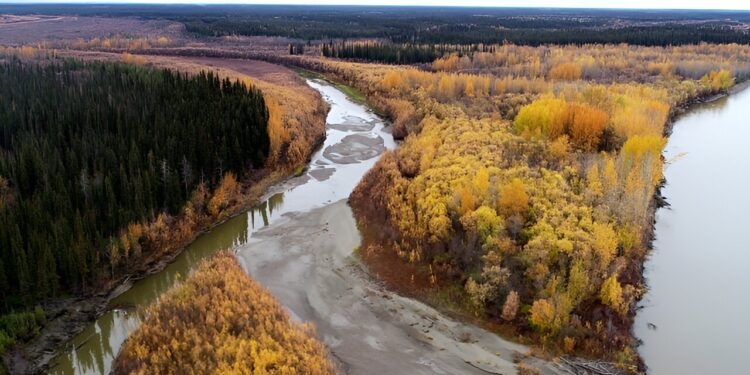A 2022 drone image of the Yukon River and its floodplain downstream from Beaver, Alaska, shows sediment accumulations that harbor mercury, a toxic metal. Credit: Michael P. Lamb.
The Yukon River flows west through Alaska toward the Bering Sea, eroding Arctic permafrost along its banks and carrying sediment downstream. Lurking in that sediment is a toxic stowaway: mercury.
As the Arctic warms under climate change, up to four times faster than the global average, mercury sequestered in permafrost for millennia is being eroded by rivers and released into the environment.
In a study published in Environmental Research Letters Now, researchers at the USC Dornsife College of Letters, Arts and Sciences are introducing a more precise method to measure the amount of mercury released from the permafrost by the river and estimate the total mercury awaiting release.
This toxic metal poses an environmental and health threat to the 5 million people living in the Arctic, more than 3 million of whom live in areas where permafrost is expected to disappear completely by 2050.
“There could be a giant mercury bomb in the Arctic waiting to go off,” says Josh West, co-author of the study and professor of Earth sciences and environmental studies at USC Dornsife. Mercury moves from the air to the ground and into the water
The planet’s natural atmospheric circulation tends to move pollutants to higher latitudes, leading to mercury accumulation in the Arctic, West said. “Because of the way it behaves chemically, a lot of mercury pollution ends up in the Arctic. The permafrost has accumulated so much mercury that it could dwarf the amount of mercury in the oceans, soils, atmosphere and biosphere combined,” he said.
In the Arctic, plants absorb mercury, then die and become part of the soil, which eventually freezes and forms permafrost. Over thousands of years, mercury concentrations build up in the frozen soil until it thaws, an increasingly common occurrence due to climate change.
The research team, which includes collaborators from Caltech, the Yukon River Inter-Tribal Watershed Council, MIT and Delft University of Technology in the Netherlands, focused its study on two villages in the northern Yukon River basin of Alaska: Beaver, located about 100 miles north of Fairbanks; and Huslia, 250 miles west of Beaver.
Previous methods for estimating mercury levels, which used core samples taken from the top three meters (about 10 feet) of permafrost, varied by up to fourfold and faced limitations due to sampling depth.
To get more precise, the USC Dornsife-led team analyzed mercury in riverbank and sandbar sediments, tapping deeper soil layers. “The river can quickly mobilize large amounts of mercury-containing sediment,” said Isabel Smith, a USC Dornsife doctoral student and corresponding author of the study.
The researchers found that mercury levels in the sediment were consistent with the highest estimates from previous studies, confirming that sediment samples provide a reliable measure of mercury content and offer deeper insight into the hidden dangers of permafrost.
In addition, the team used satellite remote sensing data to monitor the rate at which the Yukon River is changing course, which naturally changes over time. These changes in the river’s course are important because they affect the amount of mercury-laden sediment that is eroded from the river banks and deposited along sandbars. Understanding these dynamic changes is critical because they help researchers predict the movement of mercury.
Interestingly, finer-grained sediments contained more mercury than coarser-grained sediments, suggesting specific soil types that may pose greater risks.
“Taking all of these factors into account should give us a more accurate estimate of the total amount of mercury that could be released as the permafrost continues to thaw over the coming decades,” Smith said.
What damage could mercury cause?
Although mercury released into the environment by thawing permafrost does not currently pose an acute toxic threat, its effects become more pronounced over time. Exposure increases as the metal accumulates in the food chain, particularly through fish and game consumed by humans.
West notes that the risk of contamination through drinking water is minimal. “We’re not facing a situation like Flint, Michigan,” he says. “Most humans are exposed to mercury through food.”
The researchers also point out that while the river erodes the banks and mobilizes mercury-laden sediments, it also redeposits these sediments on sandbars and beaches along the banks.
“There’s another level of complexity here,” West says. “Rivers rebury a significant amount of mercury. To really understand the threat of mercury, we need to understand both the erosion and reburial processes.”
However, the long-term effects could be devastating, particularly for Arctic communities that depend on hunting and fishing.
“Decades of exposure, especially with increasing levels as more mercury is released, could have a huge impact on the environment and the health of those who live in these areas,” Smith said.
The researchers hope that the tools they have developed will allow a more precise assessment of the “mercury bomb”, in the hope that it can be defused.
More information:
M Isabel Smith et al., Mercury stocks in discontinuous permafrost and their mobilization by river migration in the Yukon River Basin, Environmental Research Letters (2024). DOI: 10.1088/1748-9326/ad536e
Provided by the University of Southern California
Quote:’Mercury bomb’ threatens millions as Arctic temperatures rise, study warns (2024, August 15) retrieved August 16, 2024 from
This document is subject to copyright. Apart from any fair dealing for the purpose of private study or research, no part may be reproduced without written permission. The content is provided for informational purposes only.



